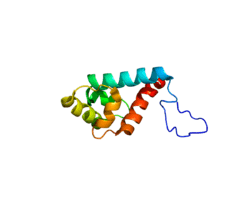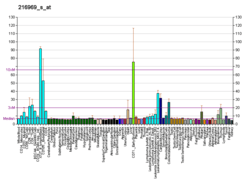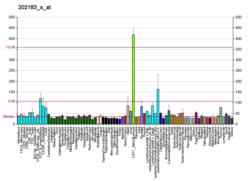KIF22
Kinesin-like protein KIF22 is a protein that in humans is encoded by the KIF22 gene.[5][6][7]
The protein encoded by this gene is a member of kinesin-like protein family. This family of proteins are microtubule-dependent molecular motors that transport organelles within cells and move chromosomes during cell division. The C-terminal half of this protein has been shown to bind DNA. Studies with the Xenopus homolog suggests an essential role in metaphase chromosome alignment and maintenance.[7]
Clinical relevance
Mutations in this gene have been shown to cause developmental disorders such as Spondyloepimetaphyseal dysplasia with joint laxity.[9]
gollark: I can't even tell what those are videos of.
gollark: So I'm not sure how that would be "immunity" in a way which isn't matched by COVID ones.
gollark: Which seems analogous.
gollark: Anyway, I checked, and apparently flu vaccines aren't always effective but do generally reduce the severity.
gollark: The mRNA vaccines were very good *originally* but the virus changed.
References
- GRCh38: Ensembl release 89: ENSG00000079616 - Ensembl, May 2017
- GRCm38: Ensembl release 89: ENSMUSG00000030677 - Ensembl, May 2017
- "Human PubMed Reference:". National Center for Biotechnology Information, U.S. National Library of Medicine.
- "Mouse PubMed Reference:". National Center for Biotechnology Information, U.S. National Library of Medicine.
- Tokai N, Fujimoto-Nishiyama A, Toyoshima Y, Yonemura S, Tsukita S, Inoue J, Yamamota T (April 1996). "Kid, a novel kinesin-like DNA binding protein, is localized to chromosomes and the mitotic spindle". EMBO J. 15 (3): 457–67. doi:10.1002/j.1460-2075.1996.tb00378.x. PMC 449964. PMID 8599929.
- Miki H, Setou M, Kaneshiro K, Hirokawa N (June 2001). "All kinesin superfamily protein, KIF, genes in mouse and human". Proc Natl Acad Sci U S A. 98 (13): 7004–11. doi:10.1073/pnas.111145398. PMC 34614. PMID 11416179.
- "Entrez Gene: KIF22 kinesin family member 22".
- Germani A, Bruzzoni-Giovanelli H, Fellous A, Gisselbrecht S, Varin-Blank N, Calvo F (2000). "SIAH-1 interacts with alpha-tubulin and degrades the kinesin Kid by the proteasome pathway during mitosis". Oncogene. 19 (52): 5997–6006. doi:10.1038/sj.onc.1204002. PMID 11146551.
- Min BJ, Kim N, Chung T, Kim OH, Nishimura G, Chung CY, Song HR, Kim HW, Lee HR, Kim J, Kang TH, Seo ME, Yang SD, Kim DH, Lee SB, Kim JI, Seo JS, Choi JY, Kang D, Kim D, Park WY, Cho TJ (December 2011). "Whole-Exome Sequencing Identifies Mutations of KIF22 in Spondyloepimetaphyseal Dysplasia with Joint Laxity, Leptodactylic Type". Am. J. Hum. Genet. 89 (6): 760–6. doi:10.1016/j.ajhg.2011.10.015. PMC 3234366. PMID 22152677.
Further reading
- Maruyama K, Sugano S (1994). "Oligo-capping: a simple method to replace the cap structure of eukaryotic mRNAs with oligoribonucleotides". Gene. 138 (1–2): 171–4. doi:10.1016/0378-1119(94)90802-8. PMID 8125298.
- Zhang S, Nonoyama M (1994). "The cellular proteins that bind specifically to the Epstein-Barr virus origin of plasmid DNA replication belong to a gene family". Proc. Natl. Acad. Sci. U.S.A. 91 (7): 2843–7. doi:10.1073/pnas.91.7.2843. PMC 43467. PMID 8146198.
- Suzuki Y, Yoshitomo-Nakagawa K, Maruyama K, et al. (1997). "Construction and characterization of a full length-enriched and a 5'-end-enriched cDNA library". Gene. 200 (1–2): 149–56. doi:10.1016/S0378-1119(97)00411-3. PMID 9373149.
- Song J, Murakami H, Tsutsui H, et al. (1998). "Genomic organization and expression of a human gene for Myc-associated zinc finger protein (MAZ)". J. Biol. Chem. 273 (32): 20603–14. doi:10.1074/jbc.273.32.20603. PMID 9685418.
- Song J, Murakami H, Yang ZQ, et al. (1998). "Human genes for KNSL4 and MAZ are located close to one another on chromosome 16p11.2". Genomics. 52 (3): 374–7. doi:10.1006/geno.1998.5452. PMID 9790757.
- Loftus BJ, Kim UJ, Sneddon VP, et al. (1999). "Genome duplications and other features in 12 Mb of DNA sequence from human chromosome 16p and 16q". Genomics. 60 (3): 295–308. doi:10.1006/geno.1999.5927. PMID 10493829.
- Funabiki H, Murray AW (2000). "The Xenopus chromokinesin Xkid is essential for metaphase chromosome alignment and must be degraded to allow anaphase chromosome movement". Cell. 102 (4): 411–24. doi:10.1016/S0092-8674(00)00047-7. PMID 10966104.
- Antonio C, Ferby I, Wilhelm H, et al. (2000). "Xkid, a chromokinesin required for chromosome alignment on the metaphase plate". Cell. 102 (4): 425–35. doi:10.1016/S0092-8674(00)00048-9. PMID 10966105.
- Germani A, Bruzzoni-Giovanelli H, Fellous A, et al. (2001). "SIAH-1 interacts with alpha-tubulin and degrades the kinesin Kid by the proteasome pathway during mitosis". Oncogene. 19 (52): 5997–6006. doi:10.1038/sj.onc.1204002. PMID 11146551.
- Levesque AA, Compton DA (2001). "The chromokinesin Kid is necessary for chromosome arm orientation and oscillation, but not congression, on mitotic spindles". J. Cell Biol. 154 (6): 1135–46. doi:10.1083/jcb.200106093. PMC 2150818. PMID 11564754.
- Strausberg RL, Feingold EA, Grouse LH, et al. (2003). "Generation and initial analysis of more than 15,000 full-length human and mouse cDNA sequences". Proc. Natl. Acad. Sci. U.S.A. 99 (26): 16899–903. doi:10.1073/pnas.242603899. PMC 139241. PMID 12477932.
- Yajima J, Edamatsu M, Watai-Nishii J, et al. (2003). "The human chromokinesin Kid is a plus end-directed microtubule-based motor". EMBO J. 22 (5): 1067–74. doi:10.1093/emboj/cdg102. PMC 150335. PMID 12606572.
- Shiroguchi K, Ohsugi M, Edamatsu M, et al. (2003). "The second microtubule-binding site of monomeric kid enhances the microtubule affinity". J. Biol. Chem. 278 (25): 22460–5. doi:10.1074/jbc.M212274200. PMID 12692123.
- Ohsugi M, Tokai-Nishizumi N, Shiroguchi K, et al. (2003). "Cdc2-mediated phosphorylation of Kid controls its distribution to spindle and chromosomes". EMBO J. 22 (9): 2091–103. doi:10.1093/emboj/cdg208. PMC 156080. PMID 12727876.
- Venkatesh LK, Gettemeier T, Chinnadurai G (2003). "A nuclear kinesin-like protein interacts with and stimulates the activity of the leucine-rich nuclear export signal of the human immunodeficiency virus type 1 rev protein". J. Virol. 77 (13): 7236–43. doi:10.1128/JVI.77.13.7236-7243.2003. PMC 164832. PMID 12805422.
- Gerhard DS, Wagner L, Feingold EA, et al. (2004). "The status, quality, and expansion of the NIH full-length cDNA project: the Mammalian Gene Collection (MGC)". Genome Res. 14 (10B): 2121–7. doi:10.1101/gr.2596504. PMC 528928. PMID 15489334.
- Tokai-Nishizumi N, Ohsugi M, Suzuki E, Yamamoto T (2006). "The chromokinesin Kid is required for maintenance of proper metaphase spindle size". Mol. Biol. Cell. 16 (11): 5455–63. doi:10.1091/mbc.E05-03-0244. PMC 1266440. PMID 16176979.
This article is issued from Wikipedia. The text is licensed under Creative Commons - Attribution - Sharealike. Additional terms may apply for the media files.






